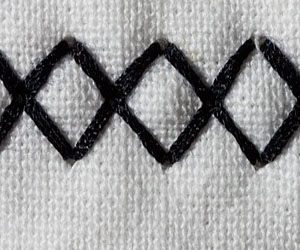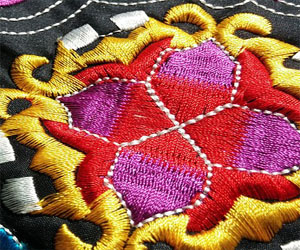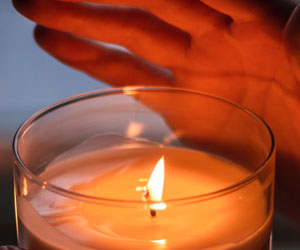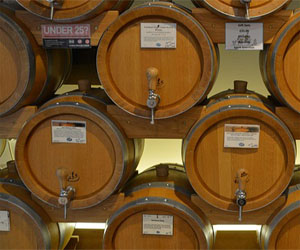


Healing Stitches For Mind And Soul

In a world where the pace of life is constantly accelerating and stress is an ever-present companion, finding effective ways to manage one's mental and emotional well-being is more crucial than ever. While traditional therapies and mindfulness practices offer valuable tools, an unexpected and delightful remedy has quietly been gaining recognition in recent years - cross-stitching therapy. This seemingly simple craft has emerged as a powerful and therapeutic practice for healing the mind and soul.
Cross-stitching therapy combines the intricate art of cross-stitch with the principles of mindfulness and relaxation, creating a practice that nurtures mental well-being. Here are some key reasons why cross-stitching therapy has gained popularity and relevance in today's hectic world:
Stress Reduction: Cross-stitching requires a high degree of focus and attention to detail. This concentrated effort diverts the mind from stressors and worries, helping reduce stress and anxiety.
Mindfulness: The repetitive nature of cross-stitching encourages mindfulness. As you methodically thread the needle and create each stitch, you enter a state of flow where your entire focus is on the present moment. This meditative quality can promote mental well-being and reduce symptoms of anxiety and depression.
Sense Of Accomplishment: Completing a cross-stitch project provides a tangible sense of accomplishment. Watching a piece of artwork slowly take shape, stitch by stitch, instills a feeling of pride and boosts self-esteem.
Emotional Expression: Cross-stitching can be a form of emotional expression. By selecting colors, patterns, and designs, individuals can channel their emotions into their creations, helping them process and cope with challenging feelings.
Distraction From Negative Thoughts: The process of cross-stitching serves as a constructive and enjoyable distraction from negative or intrusive thoughts. It can help redirect mental energy away from worries and concerns.
Connection And Community: Many individuals find solace in the cross-stitching community. Sharing projects, tips, and experiences with others can provide a sense of belonging and support, reducing feelings of isolation.
To engage in cross-stitching therapy and reap its mental health benefits, consider the following steps:
Select A Project: Begin by choosing a cross-stitch project that matches your skill level and interests. Start with simpler patterns if you're new to cross-stitching.
Gather Materials: Acquire the necessary materials, including embroidery fabric, cross-stitch thread, embroidery needles, and an embroidery hoop. High-quality materials can enhance the crafting experience.
Learn The Basics: Familiarize yourself with cross-stitching techniques and patterns. Many resources, including books, online tutorials, and classes, are available to guide beginners.
Create A Relaxing Environment: Find a quiet and comfortable space to cross-stitch. Set up your materials in an environment that promotes relaxation and mindfulness.
Set Realistic Goals: Be patient with yourself and set realistic goals. Remember that the process of cross-stitching is therapeutic, and the final piece is a beautiful byproduct.
Share Your Creations: Consider sharing your cross-stitch projects with friends, family, or the online cross-stitching community. Discussing your craft can foster a sense of connection and provide additional motivation.
Cross-stitching therapy offers a harmonious blend of creativity, mindfulness, and relaxation to support mental well-being. This time-honored craft provides a means of reducing stress, achieving mindfulness, expressing emotions, and fostering a sense of accomplishment and connection. Whether you're an experienced cross-stitcher or new to the art, consider incorporating cross-stitching therapy into your life as a therapeutic practice that stitches together healing for the mind and soul.


Crafting Beauty From The Ordinary
 Melding Form And Function: Woodworking blends form and function seamlessly. It's not just about creating a beautiful object; it's about making something that is also practical and useful. Furniture, for instance, should be comfortable and functional, while also serving as a stunning piece of decor. Woodworkers carefully consider the design, shape, and functionality of their creations, ensuring they harmonize with the artistic vision.
Melding Form And Function: Woodworking blends form and function seamlessly. It's not just about creating a beautiful object; it's about making something that is also practical and useful. Furniture, for instance, should be comfortable and functional, while also serving as a stunning piece of decor. Woodworkers carefully consider the design, shape, and functionality of their creations, ensuring they harmonize with the artistic vision.
Attention To Detail: One of the hallmarks of transforming lumber into art is the unwavering attention to detail. Woodworkers invest time and precision in every aspect of the project. From selecting the right joinery techniques to meticulously sanding and finishing, no detail is too small to be overlooked. This dedication results in a level of craftsmanship that elevates a simple piece of lumber into a masterpiece.
Creativity Unleashed: Woodworking is not confined by traditional boundaries. It encourages innovation and creativity. A piece of lumber can become a unique sculpture, an intricately designed carving, or a functional object of beauty. Woodworkers draw inspiration from a myriad of sources, and their creativity knows no bounds. The result is a diverse world of wooden art, where imagination is the only limit.
Respecting The Grain: The grain of the wood is the artist's guide, and it's essential to respect it. Woodworkers work with the grain, allowing it to dictate the direction of the project. This harmonious collaboration between artist and material ensures that the final creation is in harmony with nature. The grain becomes an integral part of the art, enhancing its character and allure.
Crafting Unique Brews In Your Kitchen
 Homebrewers often find inspiration in their surroundings and experiences. They may draw from their local environment, incorporating indigenous ingredients or regional flavors into their brews. For instance, someone living near a citrus orchard might use fresh oranges in their recipe, imparting a distinct regional character to the beer. Such a creative approach not only results in delicious brews but also connects the beer to a specific place, making it a unique and memorable experience.
Homebrewers often find inspiration in their surroundings and experiences. They may draw from their local environment, incorporating indigenous ingredients or regional flavors into their brews. For instance, someone living near a citrus orchard might use fresh oranges in their recipe, imparting a distinct regional character to the beer. Such a creative approach not only results in delicious brews but also connects the beer to a specific place, making it a unique and memorable experience.
Experimentation is another cornerstone of homebrewing creativity. Homebrewers are constantly tinkering with their recipes, trying new techniques, and pushing the boundaries of what's possible. This willingness to take risks leads to the discovery of innovative flavor combinations and brewing methods. Whether it's aging beer in oak barrels, using wild yeast strains, or adding unconventional ingredients like herbs and spices, the homebrewing world thrives on experimentation.
Furthermore, the craft beer movement has been instrumental in driving homebrewing creativity. As craft breweries continue to innovate and develop new styles, homebrewers often follow suit. They adapt commercial trends and make them their own, experimenting with hazy IPAs, sour ales, and barrel-aged wonders. The exchange of ideas between professional brewers and homebrewers has enriched both communities, resulting in a diverse spectrum of beer styles and flavors.
Unwinding Your Senses And Elevating Well-Being
 The Science Of Aromatherapy
The Science Of Aromatherapy
Aromatherapy is a holistic healing practice that uses essential oils, which are extracted from plants, to promote physical and emotional well-being. These essential oils contain natural compounds that have a range of therapeutic benefits. When inhaled, these compounds interact with the olfactory system and the brain, triggering various responses.
Aromatherapy through candles operates on this very principle. As the candle burns and releases the fragrance of the essential oils blended into the wax, these scents enter our respiratory system, affecting our mood, stress levels, and overall health.
Choosing The Right Aromatherapy Candle
The journey into the world of aromatherapy candles begins with selecting the right candle for your needs. Here are a few factors to consider:
Fragrance: The choice of fragrance depends on your goals. Lavender is known for its calming properties, making it perfect for relaxation and sleep. Citrus scents like lemon and orange are invigorating and ideal for boosting energy and focus.
Quality: Ensure that the candle you choose uses high-quality essential oils. The purity of the oils can significantly affect the therapeutic benefits.
Wax Type: Natural waxes like soy and beeswax are often preferred for aromatherapy candles because they burn cleanly and don't produce harmful toxins.






A Creative Path To Wellness
 Mindfulness: Crafting encourages mindfulness, which is the practice of being fully present in the moment. When you're immersed in a creative project, your focus shifts to the task at hand. This state of mindfulness can reduce symptoms of anxiety and depression and improve overall well-being.
Mindfulness: Crafting encourages mindfulness, which is the practice of being fully present in the moment. When you're immersed in a creative project, your focus shifts to the task at hand. This state of mindfulness can reduce symptoms of anxiety and depression and improve overall well-being.
Self-Esteem: Completing a craft project can provide a significant boost to self-esteem and self-worth. Seeing your creations come to life fosters a sense of accomplishment, pride, and a positive outlook on your abilities.
Distraction From Negative Thoughts: Crafting serves as a productive and enjoyable distraction from negative or intrusive thoughts. By focusing on the project, you can redirect your mental energy away from worries and concerns.
Social Connection: Crafting can be a social activity, allowing you to connect with others who share your interests. Joining crafting communities, attending workshops, or crafting with friends can provide a sense of belonging and reduce feelings of isolation.
Emotional Expression: Craft projects offer a creative outlet for emotional expression. Whether it's through painting, writing, or other crafts, you can channel your emotions and experiences into your creations, helping you process and cope with challenging feelings.
From Vine To Glass
 Harvesting: The timing of the grape harvest is a critical decision. Harvesting too early or too late can significantly impact the final product. In traditional wine production, grapes were often handpicked, allowing for the careful selection of ripe, healthy clusters. However, modern mechanical harvesters have also become popular for their efficiency.
Harvesting: The timing of the grape harvest is a critical decision. Harvesting too early or too late can significantly impact the final product. In traditional wine production, grapes were often handpicked, allowing for the careful selection of ripe, healthy clusters. However, modern mechanical harvesters have also become popular for their efficiency.
Crushing And Pressing: Once the grapes are harvested, they undergo a process known as crushing, where they are gently broken to release the juice. Depending on the type of wine being produced, the grapes may be destemmed, meaning the stems are removed, or they may be pressed directly. The juice obtained from this process is known as "must."
Fermentation: Fermentation is a crucial stage in wine production, as it's where the grape juice transforms into wine. Yeasts are introduced to the must to convert the sugars into alcohol. The choice of yeast and fermentation method can significantly influence the wine's flavor profile.
Aging: Aging is a key factor in wine production, especially for red wines and some white wines. Oak barrels, often used for aging, can impart flavors and aromas to the wine, adding complexity and depth. The length of aging, as well as the type of barrel used, varies based on the style of wine desired.